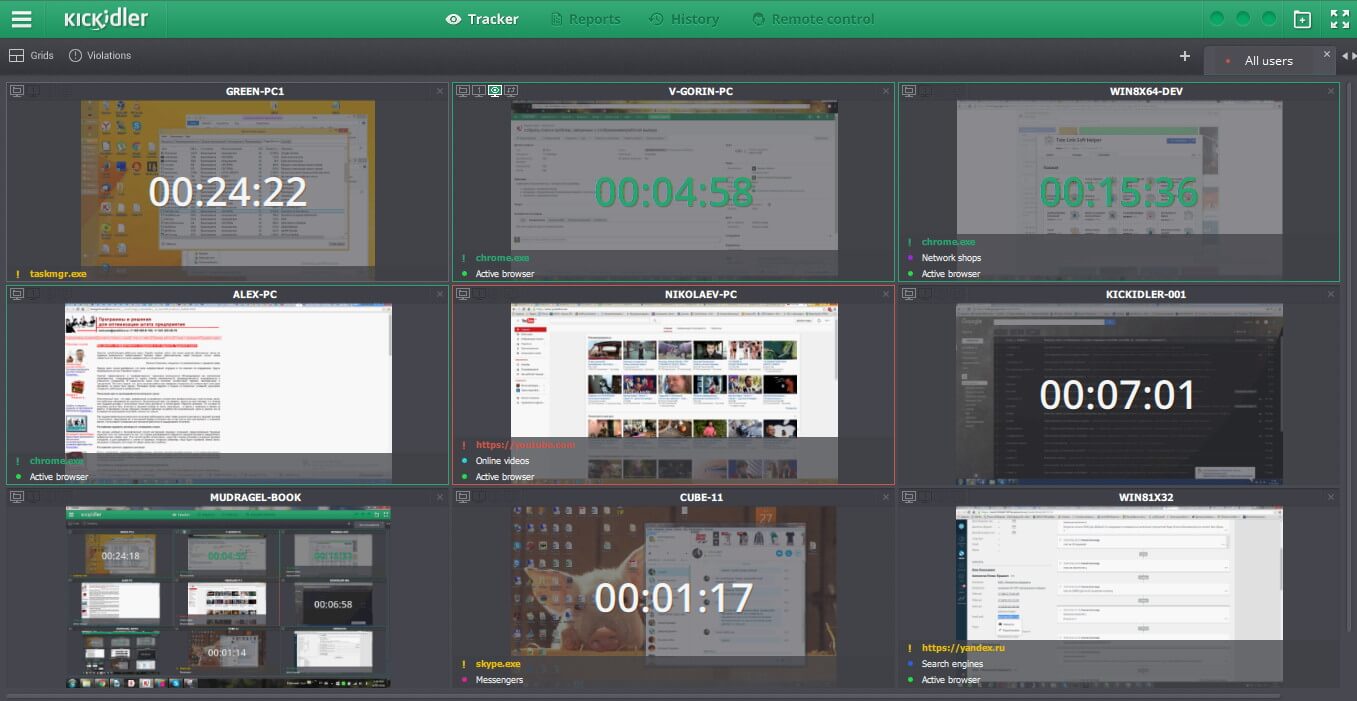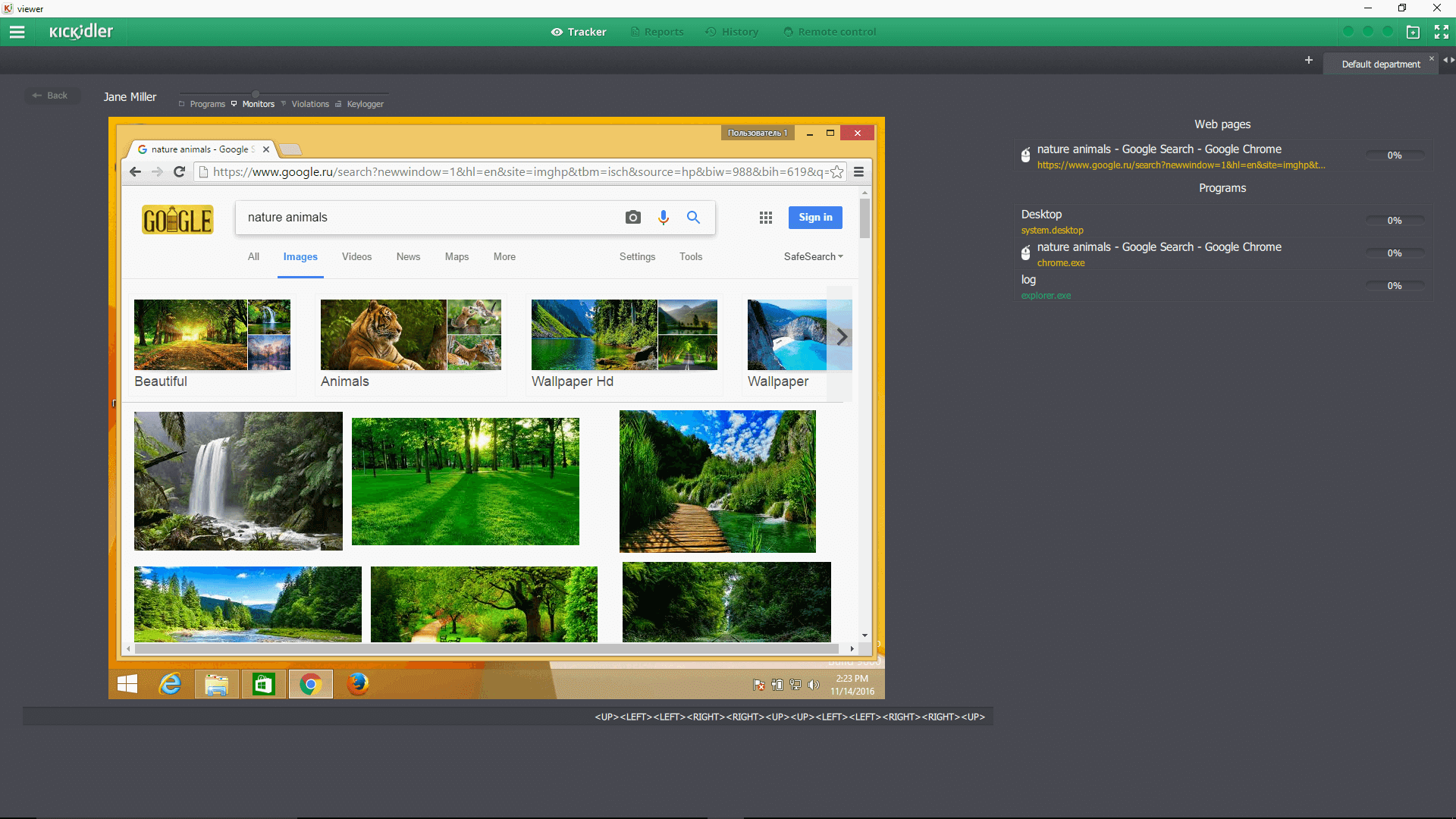Nowadays, more and more employers are turning to employee monitoring software in order to stay on top of everything that’s happening with their employees. A 2022 Instant Offices study on employee privacy found that a staggering 78% of employers are using employee monitoring tools to track work performance and activity of their employees. This trend might stem from a rising number of staff members transferring to hybrid work, where they spend some time in the office and some other working from the comfort of their own home. Seeing how fewer workers are present at the office full time, it makes perfect sense that supervisors want to keep track of their teams even when they work remotely.
Employee demand for flexible work arrangements is also high – Pulse of the American Worker Survey conducted in 2021 indicated that 87% of employees want to work from home at least one day of the week, with 68% of the workers considering the
ability to work both remotely and at the work space the ideal workplace model.
At the same time, it’s important to mention that employees are wary of certain forms of monitoring and may consider it to be a breach of trust. They worry that their privacy could be violated and might even try to resist the introduction of such software any way they can. Hence, employers need to be mindful of how their employees perceive the monitoring practices that are to be implemented.
It’s essential for employers and employees to find common ground and reach mutual understanding on this topic, and that’s why the main trend of 2022 we’re witnessing is the shift toward ethical monitoring.
In this article we’ve compiled a list of seven best practices for employers that’ll help them introduce and use employee monitoring software as efficiently and ethically as possible.
7 pillars of ethical employee monitoring
If used properly, employee monitoring can become a very powerful tool that’ll boost your team productivity and strengthen your company data security. In addition, it will help you reassure your employees and make them less resistant to the idea that they’ll be monitored in the future. So keep reading to find out some of the best practices to make the process of implementing any kind of employee monitoring software less of a challenge.
1. Determine your why
Before you introduce employee monitoring software to your team, we advise you to take a step back and clearly determine your needs for such change. What is it that you’re interested in – is it monitoring employee productivity, improving cybersecurity, tracking employee attendance, or is it something else entirely?
You should be fully clear on what you intend to achieve by monitoring your employees. This way, you’ll be able to make better decisions regarding how to use the software and what data you’ll gather with it.
Seeing how many businesses introduce employee monitoring without any clear vision for it, they end up collecting a massive of data that still leaves them unable to enact meaningful change with all their efforts. When you know your purpose for monitoring, it will make the whole process more impactful.
2. Check the regulations in your jurisdiction
The laws governing employee monitoring vary in different jurisdictions. For example, in the United States, it is legal to monitor employees in most ways without notifying them. In the European Union, on the other hand, employers are obliged to obtain employees’ consent, and some forms of monitoring (such as capturing keystrokes or taking screenshots of their monitors) may be considered illegal.
Many regulations such as Europe’s GDPR or the California Consumer Privacy Act (CCPA) require companies to monitor access to sensitive data and put measures in place to prevent potential leaks, misuse, and theft of such data.
We encourage you to check the legal requirements in your jurisdiction to make sure that you comply with them. Pay attention to any changes in legislation that concern employee monitoring and don’t forget to review compliance practices and update your monitoring policy when something changes. This way you’ll be able to avoid legal problems and financial penalties.
3. Disclose the monitoring activity
We understand that making employee monitoring a secret initiative looks rather tempting, but keep in mind that while you may learn something about your employees’ hidden oversight efforts, it won't build healthy teams – in fact, it’ll do just the opposite.
Based on the points we’ve mentioned above, such as the reasons why you’re using monitoring software and the legal requirements in your jurisdiction, you should write a clear and detailed policy. It should contain an outline of what you’re monitoring, how monitoring will be conducted, what its purposes are, how you’ll protect employee data that will be gathered in the process as well as why such monitoring is important for both data security and employee productivity.
The reason why it’s so important to create a policy is so that both employees and supervisors are aware what to expect from such monitoring and what is expected of them. It will also demonstrate your efforts to keep communication in your team transparent. Your goal is to make it unquestionably clear that you’re pursuing this priority with intentionality and meticulousness.
4. Avoid surveillance or micromanagement
It's evident that employer’s decision to introduce employee monitoring can quickly become overwhelming to said employees, undermining workplace culture when many team members already feel stressed and burned out.
While everything from mouse movements to website activity can be easily collected and analyzed with the help of monitoring software, the right thing to do instead would be to select the most important business elements, set clear expectations for tangible outcomes and develop appropriate oversight protocols for those things. In doing so, employers will empower their specialists to focus on what matters most for their businesses while providing maximum flexibility and trust.
Generally speaking, the less invasive you are, the more your team will find the monitoring acceptable. Employees already feel anxious about having their every move monitored. Your monitoring policy shouldn’t resemble spying. Your main goal should be to collect only information that’s necessary for your business.
5. Respect employee privacy
Even if your staff overall has no objections to employee monitoring software, they still may have legitimate concerns regarding their private data. To calm these anxieties, choose monitoring solutions that enable you to switch off monitoring at the end of the workday. That way your employees will get the opportunity to check social networks or respond to personal emails either before or after work.
Our advice here is simple – respect the privacy of your team members by tracking user activity only during working hours. Resort to monitoring personal emails and other forms of communication only when – and if – it directly impacts your business. Also, avoid recording such sensitive information as passwords and bank card details.
That’s why Kickidler’s Autokick feature (that we’ll talk about more in detail later) is so convenient – it enables employees to improve their self-management skills. By having an option to turn Grabber on and off themselves, employees become able to pause data collection during lunch breaks or stop it completely once they’re done with work for the day.
6. Be open to communication
Before you start monitoring the metrics you choose, take the time to have an open discussion with your employees. Try to explain how it’ll work, why it’s necessary, and how both the company and its employees will benefit from it.
Aside from that, you should also give your team some time for a trial period. This way, employees will be able to adapt to the new system, ask any questions that may arise and give you feedback. Try to listen to what they have to say and address any potential issues.
It wouldn’t be wise to make decisions regarding who is and who isn’t hard-working based solely on their performance. Even diligent and talented employees may be going through something personal that’ll make them stretched extraordinarily thin. These are people you want to keep, because in the long run they bring tremendous value to your business. Make sure that you set aside time to talk to your team members when they aren’t reaching the metrics you monitor. These conversations should reflect your understanding of the employee’s situation, and you should aim to find suitable solutions rather than making harsh decisions or threatening them with layoff.
7. Use specialized employee monitoring software
With the inevitable digitalization of workforce, an employee monitoring solution that’s specifically suitable for your company’s needs becomes incredibly helpful. But before you choose monitoring software, think of the metrics you’re intending to track and look for the best software to meet your specific needs.
It’s important to acknowledge that, ideally, such software would act as a cybersecurity solution as well, providing real-time protection against accidental and malicious insider threats. What’s more, employee monitoring software can support various productivity initiatives by providing supervisors and employees with crucial insights, helping them identify possible bottlenecks, and mitigating potential violations and risks.
Note that employee monitoring software should be as unobtrusive as possible and it shouldn’t disturb or interfere with the workflow of your employees. At the same time, keep in mind that once you decide to implement any monitoring software, you might encounter some resistance from your employees. We’ve already covered several ways specialists might try and cheat employee monitoring software, you can read about the tricks with a wristwatch here or with a keyboard here.
Ideally, when choosing the software for your specific needs, you should look at the options it offers to identify dishonest or even malicious employees. But don’t worry, we’ve got you covered – to make this search easier for you, we’ve compiled a brief overview of a trustworthy employee monitoring solution.
Using Kickidler software to monitor employees
When it comes to choosing just the right employee monitoring software, you really can’t go wrong with Kickidler. It’s a universal employee activity monitoring tool that helps you effectively monitor your teams. Kickidler records everything users see on their screens along with mouse movements and keystrokes as well as relevant metadata in a comprehensive video format.
 Day Details Report, Kickidler. This report is a summary on the working time and productivity of the employee at the computer.
Day Details Report, Kickidler. This report is a summary on the working time and productivity of the employee at the computer.
Kickidler lets you watch everything your employees are doing during their workdays, both online and in a form of recordings.
 Programm indicated productive, unproductive and the inactive screens of users who have left their work stations, along with a timer showing how long they have been gone.
Programm indicated productive, unproductive and the inactive screens of users who have left their work stations, along with a timer showing how long they have been gone.
Kickidler’s context-rich recordings include tracking of opened apps, active windows, visited URLs, keystrokes, entered commands, etc. All data is clearly associated with a certain moment in the video recording. One-click search across suspicious activity makes potential investigations more effective and faster, as well. While it records every user action, Kickidler also has filtering capabilities that allow supervisors to focus on or avoid recording certain users or applications. This way, monitoring becomes even more efficient, while respecting user privacy.
 All activities of the employee at the PC during the day are captured on the video.
All activities of the employee at the PC during the day are captured on the video.
Kickidler offers a customizable alert feature that can be used to configure any rules to trigger real-time notifications and automatic responses that can be received by both the supervisor and the employee.
 Kickidler detects work schedule violations and any other suspicious activities, notifying supervisors or employees, or both of them.
Kickidler detects work schedule violations and any other suspicious activities, notifying supervisors or employees, or both of them.
Speaking of various cunning ways employees might try to cheat the monitoring software, Kickidler isn’t that easy to fool, with its online monitoring & screen video recording features coming in handy when you notice any deviations that might need further investigation.
 The recording of employee activities will help you organize the work in your company as efficiently as possible. You will be able to control the execution of orders, watch videos on any selected application (e.g. Skype), and by periods of violations.
The recording of employee activities will help you organize the work in your company as efficiently as possible. You will be able to control the execution of orders, watch videos on any selected application (e.g. Skype), and by periods of violations.
The software also offers a variety of easily customizable reports that will be useful in evaluating security risks and measuring employee performance.
 Each column of the chart shows the number of productive, unproductive, and neutral activities and activity without category.
Each column of the chart shows the number of productive, unproductive, and neutral activities and activity without category.
By using Kickidler employee monitoring software, you ensure comprehensive employee monitoring and benefit from such helpful features as:
- online monitoring of employees’ computers;
- continuous session recordings in video format;
- remote access to employees’ monitors;
- keystroke monitoring and multi-monitor recording;
- monitoring only during specified time intervals;
- automatic notifications to supervisors;
- automatic notifications to employees that ensure self-monitoring;
- web page and application monitoring;
- productivity analysis by specific employees, teams or the whole company, etc.
Lastly, it’s worth describing Kickidler’s Autokick feature a bit more in-depth. This set of tools provides immense help with carrying out employee monitoring in an ethical way. Autokick includes tools that enable self-monitoring and automatic notifications of violations.
Self-monitoring tools allow employees themselves to see reports on their user activity and productivity. Autokick displays personal statistics, including the amount of productive, unproductive and neutral time as well as the time of inactivity and the total number of hours worked.
 For an ordinary employee, Autokick can be considered an alarm clock that, if necessary, will trigger an alarm and remind them that they should probably work better.
For an ordinary employee, Autokick can be considered an alarm clock that, if necessary, will trigger an alarm and remind them that they should probably work better.
Automatic notifications notify employees about potential work irregularities. Among other things, employees who have been working for an extended period of time can receive notifications that remind them to take a small break. Supervisors can also configure notifications on violations will be sent to their email. Flexible settings allow supervisors to define what will be considered a violation for certain employees, different teams or even for the company as a whole.
Another incredibly useful Autokick’s feature is that it provides employees with the ability to turn Grabber on and off themselves. By switching the monitoring off at the end of a workday, employees that work from home can easily use the software on their home PCs without any risk of it compromising their privacy.

Self monitoring, Kickidler
And one more thing – recently, the developers have updated Autokick’s design, so now it’s even more intuitive and user-friendly. Even if some people on your team aren’t as tech-savvy as the others, this feature is really uncomplicated in use.
Hopefully, with this article we’ve proven to you that introducing and using employee monitoring software doesn't have to be weird, radical or creepy. Instead, it's an incredibly capable aide for any business that can help deliver great returns when implemented with purpose.
Good luck!

 ENG
ENG 
